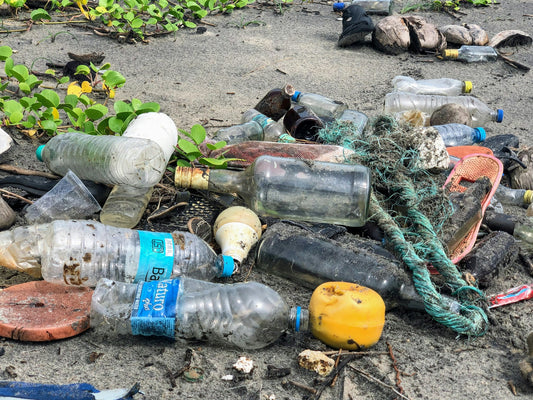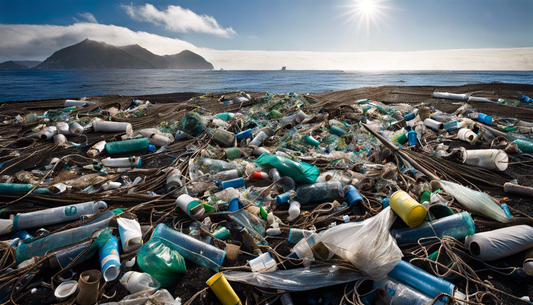Share
Fashion—a word that often conjures up images of glamorous runway shows, sleek ads and influencers showing off their fashion haul with the excitement of a new season's trends. But beneath the surface of the fashion industry lies a darker reality, one that often gets swept under the rug.
This reality is fast fashion—the industry’s relentless push to produce cheap, trendy clothing at breakneck speeds. And while fast fashion has made it possible for more people to keep up with the latest styles, it has come at an immense cost, both ethically and environmentally.
The Ethical Dilemma
Labour Cost

Fast fashion is cheap for a reason. The low prices we see on clothing racks are a direct result of exploitation. Garment workers, primarily in developing countries, often face horrific working conditions. Long hours, meager pay, and unsafe environments are all too common.
Bangladesh has been a hub for global fast fashion brands like H&M, Zara, and Gap. The garment industry here is now valued at $55 billion annually. However, there have been widespread protests recently over poor wages and working conditions. This instability has already led several major brands, such as Walmart and Disney, to shift production elsewhere. The unrest has highlighted the deep ethical concerns that continue to plague Bangladesh’s garment sector, despite its crucial role in lifting millions out of poverty.
The Environmental Consequences
Fashion isn’t just filling our closets; it’s filling our landfills too. Every year, millions of tons of textile waste are generated, much of which ends up in landfills or incinerators. These discarded clothes take years to decompose, releasing toxic chemicals and greenhouse gases in the process.
Moreover, fast fashion’s reliance on synthetic fibers like polyester means that even more damage is being done. These fibers shed microplastics every time they’re washed, which then make their way into our oceans, contributing to the devastating impact on marine life and ultimately, the food chain.
The Role of Big Brands
Major fast fashion brands have faced growing scrutiny over their labour and environmental practices. In response, many have launched “sustainable” clothing lines, adopted eco-friendly marketing campaigns, or made donations to environmental causes. While these actions seem like steps in the right direction, they often serve as superficial gestures, designed to improve a brand’s image rather than address the core issues. Critics argue that these efforts, often termed “greenwashing,” distract from the real need for systemic change across the entire production process.
Consumer Responsibility
With all the knowledge we have today about fast fashion’s ethical and environmental impact, the challenge lies in us making responsible choices as consumers. On one hand, fast fashion offers trendy clothing at affordable prices, making it accessible to a larger audience. On the other hand, ethical alternatives, such as sustainably produced garments, can be more expensive, limiting accessibility for many. Striking a balance between affordability, personal values, and environmental responsibility can be a difficult task, especially in a culture driven by trends and the desire for newness. However, even small changes—like buying less, choosing second-hand, or supporting ethical brands—can have a meaningful impact.
Moving Towards Sustainable Clothing

The good news? We can make a difference. By moving away from fast fashion and towards more sustainable clothing choices, we can help reduce the industry's impact on both people and the planet. Here are some steps to get started:

-
Thrift: The thrifting trend is growing today more than ever before. More and more people are interested in second-hand fashion and it’s evident. Online resale platforms, social media businesses, clothing swaps, garage sales and pop-up thrift shops have taken the second-hand industry by storm. American-based online thrift store ThredUp reported that by 2027, the value of the fashion resale market would double to $3.5bn. Thrifting not only reduces the demand for new clothing, but it also keeps garments out of landfills.
-
Choose Sustainable Brands: When buying new, opt for brands that prioritize ethical production practices and sustainability. Look for certifications that guarantee fair wages, safe working conditions, and environmentally friendly practices. Be wary of greenwashing, though—some brands may claim to be eco-friendly without truly committing to sustainable practices.
-
Repair, Reuse, Repurpose: Before tossing out that worn-out T-shirt or those holey jeans, consider repairing them. Simple fixes can extend the life of your clothes, reducing the need to buy new ones. And if you’re feeling creative, upcycling old garments into something new can be a fun and rewarding project.
-
Think Twice Before Buying: Do you really need that new dress, or are you just caught up in the thrill of shopping? Being mindful of your purchases and resisting the urge to buy on impulse can significantly cut down on waste. Remember, every item of clothing you choose not to buy is one less item contributing to the cycle of fast fashion.
- Support Local and Artisanal Brands: Local brands often have a smaller carbon footprint compared to large, global fast fashion brands. Plus, they’re more likely to use sustainable materials and ethical production methods. By supporting these businesses, you’re also supporting your local economy and helping to promote more sustainable fashion practices.
A Call to Conscious Fashion

Fast fashion is tempting, no doubt about it. The allure of low prices and ever-changing styles can make it hard to resist. But as consumers, we hold immense power. By choosing to shop sustainably, we can push the fashion industry towards more ethical and eco-friendly practices. It's not just about what we wear—it's about the kind of world we want to live in. So, let’s make sure our clothing choices reflect the values we hold dear: fairness, sustainability, and respect for our planet and all its inhabitants.
What is your thought about fast fashion? Let us know in the comments.
We hope you enjoyed this article. If you want to read more like this, make sure to check out our Blog and follow us on Instagram. If you are interested in truly sustainable products, check out our Shop.
Author bio:
Cassy is an eco-enthusiast and waste warrior at our partner ZeroWasteNest.com, passionate about helping everyone—from zero-waste beginners to seasoned pros—make sustainable living choices that actually stick 🌎. With a focus on small changes that add up, she breaks down daunting steps into easy, doable actions while adding her own personal anecdotes, practical tips, and a dash of sass. Whether she’s thrifting, crafting DIY beauty products, or writing for ZeroWasteNest, Cassy’s mission is to inspire us all to live greener and more intentionally.








